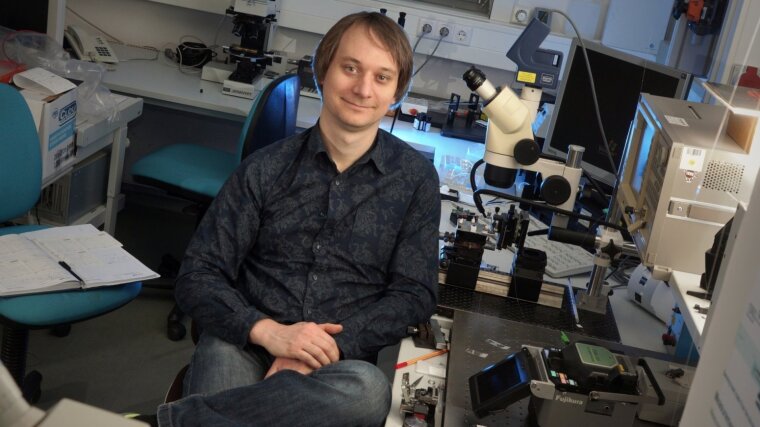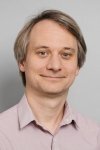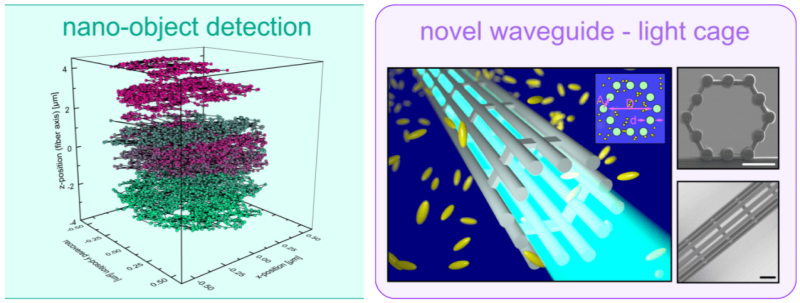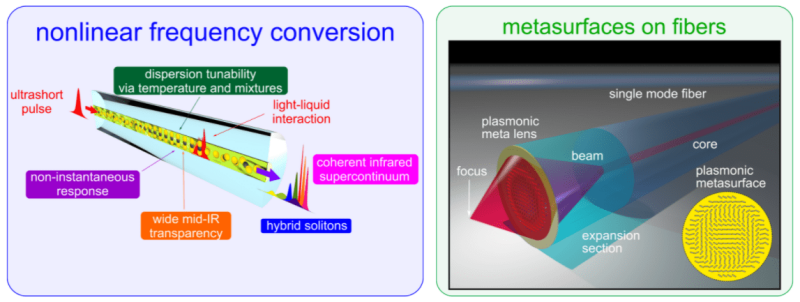
Markus SCHMIDT
Image: PrivateProf. Dr. Markus A. SCHMIDT
Email: markus.schmidt@ipht-jena.de
Phone: +49 3641-2-06140
Markus A. Schmidt owns a full professorship for Fiber Optics at the Friedrich Schiller University Jena and is head of the research department Fiber Photonics at the Leibniz Institute for Photonic Technologies (IPHT), leading the working group Hybrid Fibers.
Optical fibers provide an ideal base for novel nanophotonic devices due to their unique optical properties, outperforming the properties of planar waveguides in many cases. The Fiber Sensor Group (FSG) at the Institute of Photonic Technology (IPHT), a team of highly motivated specialists concentrates on implementing novel optical concepts and placing nanostructured elements into fibers and using these devices in various areas of optics, mainly in biophotonics. Currently we are focusing on plasmonic and metamaterials in fibers - realized by placing nanoscale metallic wires and elements into fibers - in order to observe exciting effects such as Fano resonances or slow light. Furthermore we are targeting electrically active fibers for electro-static particle traps, and we are keen on placing unusual materials into the fibers such as chalcogenide, liquids or semiconductors to implement all kinds of in-fiber devices in areas such as nonlinear optics, modulators or integrated detectors. The group is located at the IPHT in Jena and has a Europe-wide outstanding infrastructure to facilitate nano- and microstructured optical fibers. We work very close together with the photonics people from the local university and from industry.
Research Areas
Prof. Schmidt currently focusses his research on fibers and waveguides with applications in areas such as biophotonics, optofluidics, and nonlinear optics. Current research interests include:
- Propagation of light in novel waveguides implemented by 3D nanoprinting or fiber drawing (e.g. hollow-core light-cages)
- Beam manipulating by functionalizing optical fibers with metasurfaces or plasmonic nanostructures
- Nano-object detection (e.g., viruses etc.) inside waveguides for biosensing via measuring Brownian motion
- Ultrafast nonlinear light generation (e.g., soliton-based supercontinuum generation)
Teaching Fields
Prof. Schmidt’s teaching is devoted to the early involvement of young developing scientists in state-of-the-art research. Currently, he holds two courses in:
- Fiber optics (summer semester)
- Active Photonics Devices (winter semester)
Research Methods
The infrastructure at the Leibniz Institute of Photonic Technology and the laboratories led by Prof. Schmidt offer a wide range of methods for the fabrication and characterization of all kinds of optical fibers, including:
- Ultrashort pulse lasers
- Microscopic tracking setup, image processing tools
- 3D nanoprinting (Nanoscribe)fiber-drawing tower
- Various spectrometers, transmission setup, lasers and other light sources
Left: In-fiber nano-object by means of analyzing Brownian motion. Right: Optofluidic light cage, representing an example of a 3D-nanoprinted hollow waveguide structure.
Illustration: Schmidt research groupRecent Research Results
Markus A. Schmidt has focused his research on fibers and waveguides with applications in areas such as biophotonics, optofluidics, and nonlinear optics. One large fraction of the research of the group of Prof. Schmidt targets nano-object detection [1-3]. Here the Brownian motion of objects which are substantially smaller than the diffraction limit of light is statistically analyzed, which represents a key technology in modern bioanalytics (e.g., virus ensemble characterization). In the group of Prof. Schmidt, freely diffusing nano-scale objects are introduced into the holey channel of microstructured fibers and the trajectory of the diffusion is analyzed via side-wide microscopic detection. One recent research examples includes the three dimensional recovery of the trajectory of the diffusion of a gold nanosphere inside a modified step index fiber (left). The development of novel types of hollow waveguides also represents one intensively followed research directions. Here 3D nano-printing is used to realize waveguides such as light cages (right) which allow guiding light inside an array of freely suspended strands which unique give side-wise access to the hollow core [7-9]. This project which is carried out in close collaboration with our partner group at LMU Munich (Prof. Stefan Maier) allows for the integration of novel types of nonlinear and sensing devices as being demonstrated.
Left: Key features of nonlinear frequency conversion in liquid core fibers. Right: Example of fiber-integrated plasmonic metasurfaces mediated light focusing.
Illustration: Schmidt research groupAnother key research area in the group of Prof. Schmidt addresses nonlinear frequency conversion within highly confining hybrid waveguides [4-6]. Currently the group is intensively working on soliton-based supercontinuum generation in liquid core fibers, which via the non-instantaneous response of the liquid core material yields novel type of nonlinear excitations (e.g., hybrid solitons) and temporally stable broadband spectra. Moreover novel kind of dispersions tuning schemes (e.g., resonance mediated tuning via nanofilms (left)) are employed to desirably shape nonlinear processes and output spectra. Metasurfaces represent a promising pathway to manipulate the flow of light via defined scattering of an ensemble of nano-engineered scatteres [10-12]. Within this project, metasurfaces are created on the end faces of optical fiber by means of either nano-printing or electron beam lithography (right). This leads to effects such as fiber-integrated focusing for optical trapping applications or highly sensitive optical responses for bioanalytics.
[1] Jiang et al., Nanoscale 12, 3146 (2020).
[2] Jiang et al., Nanophoton. 8, 4545 (2020).
[3] Faez et al., ACS Nano 9, 12349 (2015).
[4] Lühder et al., Laser & Photon. Rev. 14, 1900418 (2020).
[5] Sollapur et al., Light: Sci. & App. 6, e17124 (2017).
[6] Chemnitz et al., Nature Commun. 8, 42 (2017).
[7] Jang et al., Opt. Lett. 45, 196 (2020).
[8] Jang et al., Opt. Lett. 44, 4016 (2019).
[9] Jain et al., ACS Photonics 6, 649 (2019).
[10] Wang et al., ACS Photonics 6, 691 (2019).
[11] Wang et al., Opt. Mater. Express 8, 2246 (2018).
[12] Zeisberger et al., APL Photonics 2, 36102 (2017).
Link to the Fiber Optics Group of the IPHT JenaExternal link


